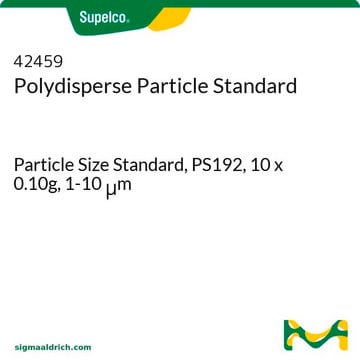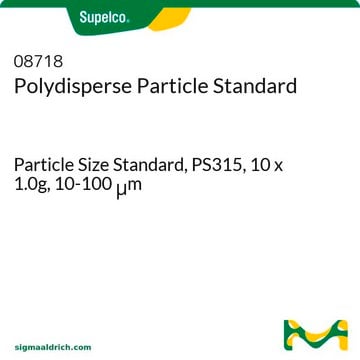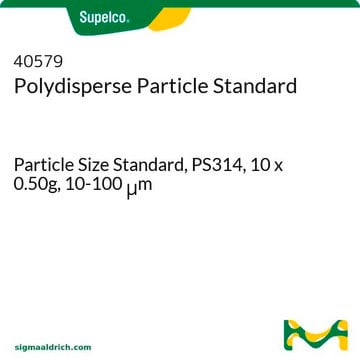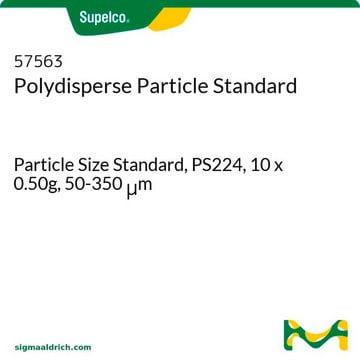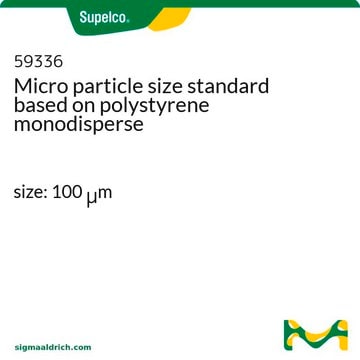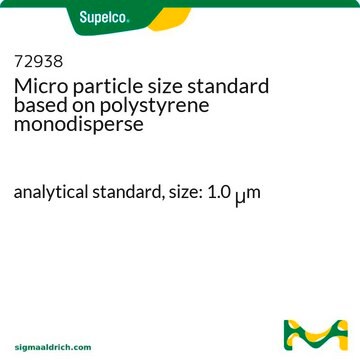94078
Polydisperse Particle Standard
Particle Size Standard, PS202, 10 x 0.10g, 3-30 μm
Synonym(s):
Particle size distribution standard
Sign Into View Organizational & Contract Pricing
All Photos(1)
About This Item
UNSPSC Code:
41116107
NACRES:
NA.24
Recommended Products
grade
analytical standard
form
particles
manufacturer/tradename
Whitehouse Scientific Ltd PS202
particle size
3-30 μm
application(s)
glass & ceramic
industrial qc
pharmaceutical
format
neat
Looking for similar products? Visit Product Comparison Guide
Related Categories
General description
Polydisperse Particle Standard (PS202, size: 3-30 μm) is a particle size standard, ideal to determine the particle size distribution (PSD) of a particle system.
This product is produced by using gravitational sedimentation, microscopy and Coulter counter.
This product is produced by using gravitational sedimentation, microscopy and Coulter counter.
Application
Used to standardize particle size equipment.
It used to determine the precision and reproducibility of laser diffraction particle sizer.
It used to determine the precision and reproducibility of laser diffraction particle sizer.
Features and Benefits
- suitable for routine instrument calibration checks, testing and corrections
- available as a neat sample
Signal Word
Danger
Hazard Statements
Precautionary Statements
Hazard Classifications
Eye Dam. 1 - Skin Corr. 1B
Storage Class Code
8B - Non-combustible corrosive hazardous materials
WGK
WGK 1
Flash Point(F)
Not applicable
Flash Point(C)
Not applicable
Personal Protective Equipment
dust mask type N95 (US), Eyeshields, Gloves
Choose from one of the most recent versions:
Already Own This Product?
Find documentation for the products that you have recently purchased in the Document Library.
Customers Also Viewed
Atmospheric dust dynamics in southern South America: A 14-year modern dust record in the loessic Pampean region
Cosentino NJ, et al.
Chemosphere, 30(4), 575-588 (2020)
Ground/satellite observations and atmospheric modeling of dust storms originating in the high Puna-Altiplano deserts (South America): Implications for the interpretation of paleo-climatic archives
Gaiero DM, et al.
Journal of Geophysical Research: Atmospheres, 118(9), 3817-3831 (2013)
New insights on sources contributing dust to the loess record of the western edge of the Pampean Plain during the transition from the late MIS 2 to the early Holocene
Torre G, et al.
Chemosphere, 30(4), 537-545 (2020)
Revisiting the chronology and environmental conditions for the accretion of late Pleistocene-early Holocene Pampean loess (Argentina)
Torre G, et al.
Chemosphere, 213, 105-119 (2019)
The paleoclimatic message from the polymodal grain-size distribution of late Pleistocene-early Holocene Pampean loess (Argentina)
Torre G, et al.
Chemosphere, 42, 100563-100563 (2020)
Our team of scientists has experience in all areas of research including Life Science, Material Science, Chemical Synthesis, Chromatography, Analytical and many others.
Contact Technical Service